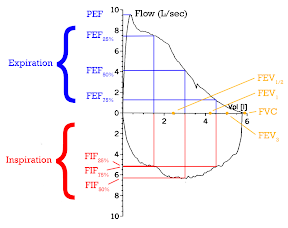Forced oscillometry as an effortless test detects small airway obstruction better than spirometry in asthma
 Forced oscillometry (resistance at 5, 20, and 5-20 Hz) requires passive cooperation of the patient breathing normally vs. the active participation during spirometry.
Forced oscillometry (resistance at 5, 20, and 5-20 Hz) requires passive cooperation of the patient breathing normally vs. the active participation during spirometry.This small study from Egypt included 50 patients with stable asthma at age 50 and matched healthy controls. All patients with asthma had airway obstruction, 8% had isolated small airway obstruction, 10% had isolated large airway obstruction, and 82% had large and small airway obstruction.
By forced oscillometry, 12% had normal airway resistance, 50% had isolated small airway obstruction with frequency-dependent resistance, and 38% had large and small airway obstruction with frequency-independent resistance. There was significant difference between techniques for the detection of the site of airway obstruction (P = .012).
Forced oscillometry is an effortless test, conducted during quiet tidal breathing, and does not alter airway caliber. Forced oscillometry detected isolated small airway obstruction better than spirometry in asthma.
References:
Forced oscillometry track sites of airway obstruction in bronchial asthma. Hafez MR, Abu-Bakr SM, Mohamed AA. Ann Allergy Asthma Immunol. 2015 Jul;115(1):28-32. doi: 10.1016/j.anai.2015.04.017. Epub 2015 May 21.
http://www.ncbi.nlm.nih.gov/pubmed/26004425
Image source: Spirometry, from Wikipedia, the free encyclopedia, GNU Free Documentation License.
As some of you know, I have been the Editor of the World Allergy Organization (WAO) Small Airways Working Group "What's New?" monthly summary since 2011. The summary features the top 3 asthma/small airways articles each month. The article above is part of the project. The archive is here: http://www.worldallergy.org/small_airways_group/reviews/archive.php